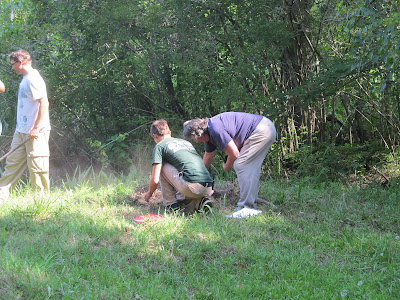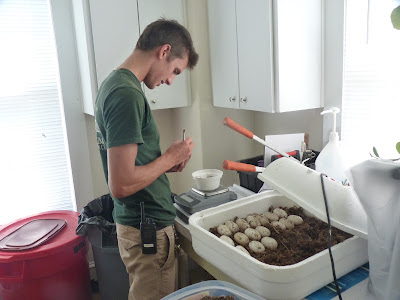In May of 2011, we brought in two female alligators from St. Augustine Alligator Farm. Both girls were about six feet long and weighed about 28 kg (62 pounds). After their quarantine, the girls joined our 12 foot male alligator in the exhibit. He has lived at the zoo since the 1970's, and we estimate his age to be 65-70 years. He tolerated both females very well, but has paid special attention to one of them. Look at the difference in their sizes!
In May of this year, we saw the female building a nest very close to the visitor area. Alligator nests look like a pile of mud, grasses, and twigs that help regulate the temperature of the eggs.
Zookeepers checked the nest on May 18th. There were no eggs, but the female continued to guard the nest. Then she built a second nest on the other side of the exhibit!
On July 10, 2012 we decided to check both nests for eggs. Zookeepers Kevin and Matt prevented the female from charging as our Curator Andrea and Intern Caleb, dug up the nest. (Notice that I volunteered to be spotter from outside the exhibit!) The nest in the above photo contained 48 eggs - 46 of which were intact!
We had already decided to remove the eggs from the exhibit. If the babies hatched on exhibit, the tiny hatchlings could escape through the fencing, or even be eaten by the male. Female alligators guard their babies, but a male alligator may have a hard time passing up a free meal. Zookeepers had to mark each egg and be careful not to tip it. Alligator eggs will not hatch if flipped over.
We moved on to the next (original) nest, and sent our intern to dig it up. Matt and Kevin had to guard Caleb because the male alligator was not happy with the zookeepers.
We had ourselves a little National Geographic moment, but everyone did a great job, and the procedure went very well.
Each egg was labeled, weighed, and placed in an incubator. We cannot tell whether the eggs are fertile, but may be able to tell in a week or so. If fertile, the eggs should hatch within the month!
.JPG)
.JPG)







No comments:
Post a Comment